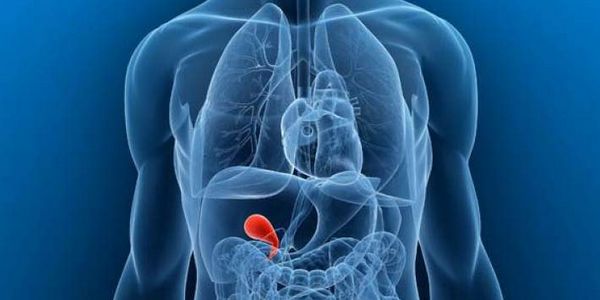Kholangit – treatment of disease. Symptoms and prevention of diseases of Cholangitis

Kholangit – What is this disease? Cholangitis is acute or chronic non-specific inflammation of the bile ducts, occurs due to skidding infection in them haematogenously, limfogenno, from the intestines or gallbladder.
This pathology more often combined with cholecystitis, hepatitis, gastroduodenitom, pancreatitis, gallstone disease, rather than evolving as an independent disease. Women get sick more often than men holangitom.
Kholangit – Causes cholangitis
The main and the most frequent cause of cholangitis is allergy infectious agents in the bile ducts to background broken their patency. Bile duct patency violation occurs, usually, on one of the following reasons:
- cholelithiasis (choledocholithiasis);
- cicatricial stricture bilious ways due to chronic cholecystitis;
- tumor and cyst exeresis (common gall duct);
- postcholecystectomical syndrome (condition after gall bladder removal);
- glistnaya invasion (overlapping zhjolchevyvodjashhih ducts Ascaris, eg);
- stenosis papilla.
Pathogens (enterococci, Escherichia coli, staphylococci, Proteus, neklostridial'naja anaerobic infection, etc.) can penetrate the bile path upward through the (often) from the lumen of the duodenum, from the gall bladder in septic cholecystitis, haematogenously (via vorotnuju vein) or limfogenno (at jenterite, holetsistite, pancreato, gepatite). Parasitic cholangitis may develop at jehinokokkoze, opistorhoze, giardiasis, shistosomoze, klonorxoze, fascioljoze, strongiloidosis and certain other invasions. Aseptic cholangitis may also occur against the backdrop of such diseases and conditions:
- pankreatobiliarnyj reflux (against the backdrop of enzymatic irritation);
- Autoimmune sclerosing cholangitis combined with Crohn's disease, nonspecific ulcerative colitis, vasculitis, thyroiditis, Rheumatoid arthritis, etc.;
- iatrogenic damage during endoscopic bile duct wall manipulation (When you install Stents, Retrograde Cholangiopancreatography, sfinkterotomii, surgical interventions).
Symptoms of cholangitis
Clinical manifestations of acute cholangitis occur suddenly in the form of the classical Charcot's triad, includes pain in the right hypochondrium, increased body temperature and jaundice. The temperature usually rises to 38-40° c and is accompanied by a pronounced sweating and chills. Pain intense enough, by their nature resemble zhjolchnuju colic and radiating in right shoulder, the neck and under the shoulder. Intoxication in acute inflammatory narostaet quickly and manifest deterioration appetite, progressive weakness, headache, diarrhoea and vomiting with preceding nausea. Several later appears jaundice, accompanied by skin itching (especially at night). In severe cases, the above symptoms may join the shock and sense of violation (pentada Reynolds).
In chronic inflammatory symptoms are stjortyj in nature, but also improves. Dull pain in the right podreberie have weak intensity, accompanied by bloating sensation in epigastralna area. Jaundice develops much later and reveals the long-term ongoing process.
Diagnosis of cholangitis
With a view to the diagnosis of cholangitis following laboratory and instrumental research methods:
- biochemical blood analysis (increased levels of bilirubin, hepatic transaminases, alkaline phosphatase, alpha-amylase);
- factional duodenal intubation with further bacteriological study of bile (with the aim of identifying pathogens);
- the study of helminth eggs and feces elementary;
- ULTRASOUND of the liver and abdominal ultrasound, CT, ultrasonography bilious ways (defines an extension ducts, structural and endemic changes in liver parenchyma, etc.);
- Endoscopic Retrograde percutaneous transhepatic cholangiography;
- Percutaneous chrespechjonochnaja c cholangiogram;
- magnetic resonance pancreat-c cholangiogram.
Kholangit – Types of disease
Depending on the nature of the currents, emit the acute and chronic cholangitis. Acute cholangitis, in turn, share on catarrhal, purulent, difteriticheskij and Necrotizing. Same chronic cholangitis may be hidden (latent), recurrent, abscedirujushhim and septic. Separately, emit a special form of chronic autoimmune cholangitis sclerosing cholangitis-.
Kholangit – Actions of the patient
If there are previously described symptoms should consult a specialist.
Treatment of cholangitis
Treatment for cholangitis is knocking the inflammatory process, detoxification, as well as the decompression bilious ways and eliminating complications. During comprehensive treatment apply antibacterial, antiparasitic, anti-inflammatory, antispasmodics, hepatoprotectors and infusion therapy. After knocking over the aggravation of (in the period of remission) apply the physiotherapeutic methods of treatment. For bile duct decompression surgery is often required (including endoscopic methods).
Kholangit – Complications
Cholangitis may worsen following diseases: cirrhosis, abscedirovanie, sepsis, hepatic insufficiency, etc.
Kholangit – Prevention
Prevention of occurrence of cholangitis is prompt treatment of other pathologies of the digestive tract (gastroduodenitis derangement, cholecystitis, etc.), worm infestations and observation at the gastroenterologist after surgical interventions on the galbladder and zhjolchevyvodjashhih ways.
